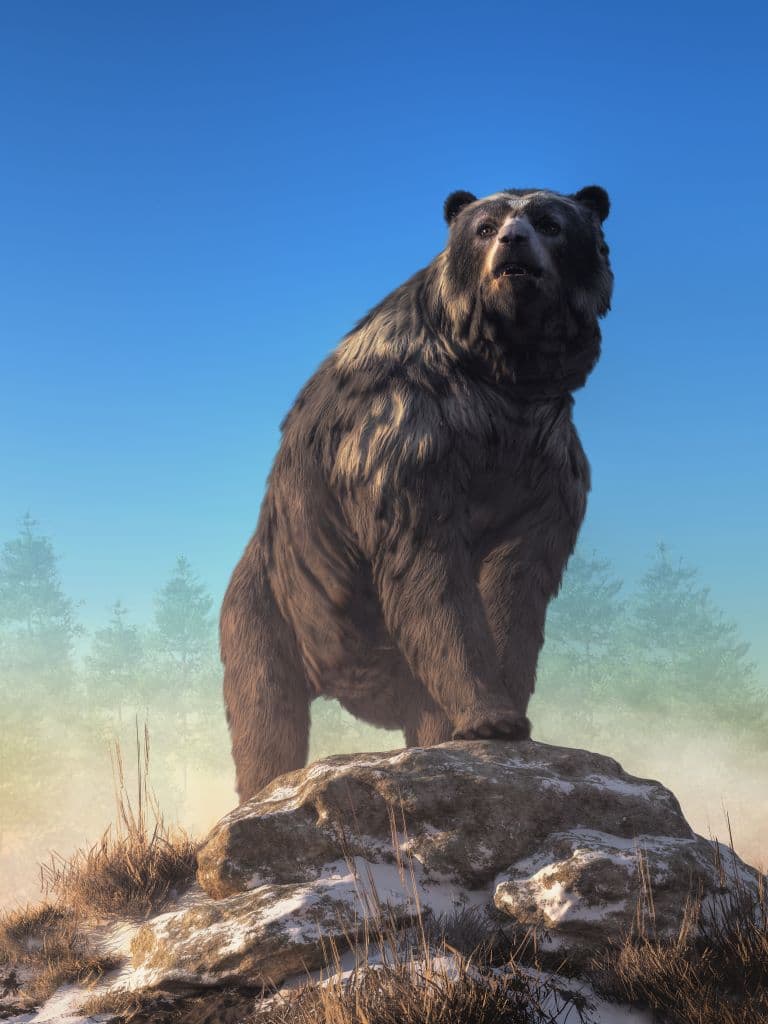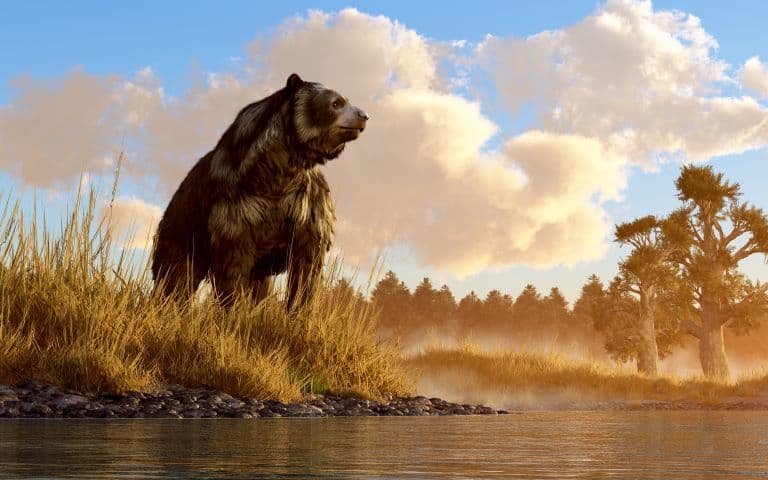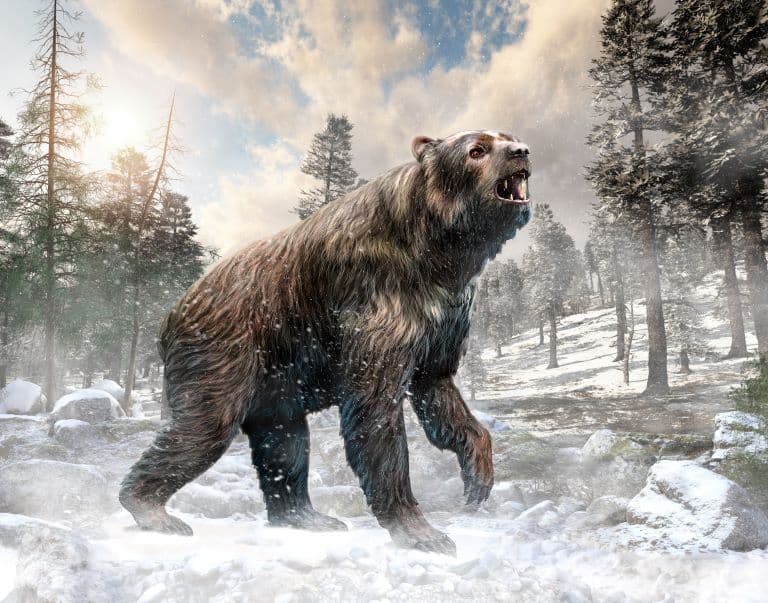Arctodus Profile
Nowadays, the most terrifying and dangerous animal likely to violently hinder your progress across the American continent is the modern American itself. But things weren’t always like this.
When humans first radiated into what is now the US, the ancestors of Native Americans truly set up a “home of the brave”, as they immediately had to deal with three-metre-tall bears that could bite you in half.

Arctodus Facts Overview
| Habitat: | Diverse: Savanna to Forest, preferring open woodlands |
| Location: | North America |
| Lifespan: | Unknown |
| Size: | 1.6 metres (5 ft 3 in), over 3 metres (10 ft) when standing |
| Weight: | Up to 2000kg (2200lb) |
| Colour: | Unknown |
| Diet: | Omnivorous and carnovorous: vegetation and large herbivores |
| Predators: | None |
| Top Speed: | Possibly up to 65km/h 41mph |
| No. of Species: | 2 |
| Conservation Status: | Extinct |
Arctodus was one of two genera of short-faced bears and contained the species that would have welcomed early humans to the North American continent.
So much about these mythologised bears is debatable and yet to be confirmed, due to a lack of complete fossils, but it’s safe to say that this was a large carnivore with a fast pace, and would have been one of the keystone species in any number of the diverse ecosystems in which it lived.
Interesting Arctodus Facts
1. The lesser version didn’t make it
Reaching back quite a bit further than human migration into the Americas (as far as we currently understand it), there would have been a species of Arctodus that wasn’t quite as fearsome.
This ‘lesser’ shot-faced bear, Arctodus pristinus, is thought to have been a little more omnivorous, much closer to modern black and brown bears, lived around Mexico and the Atlantic coast, and went extinct sometime around 300,000 years ago, along with other genera of (Arctotherium: even more terrifying[This would be a great one do cover if you want to do older animals; it was probably the largest land carnivore ever]) short-faced bears from South America.
This could have been due to competition from the ancestors of extant bear species on the continent such as the black and grizzly, and a reasonably close relative remains in South America in the Spectacled bear.
Fossils are few and far between in both species, so the range and extinction data are a little sparse, but the smaller species certainly disappeared long before the monster that would have fed on stone-age humans.

2. What remained was horrifying
While the diet and size of A. pristinus was a lot more in line with our comfort zone as humans, the larger species, Arctodus simus, was about as scary as it gets for terrestrial predators.
This was possibly a far more serious carnivore, and certainly more than large enough to deliberately hunt our ancestors for food.
Males were enormous, sometimes up to, and possibly more than a ton in weight, and certainly one of the largest carnivores ever to roam the land.
This giant was far from lumbering, too. It would have been an agile hunter, packed with muscle and with good stamina.
A huge nasal cavity suggests both a good sense of smell and the ability to chase prey for long distances. The jaws are short and wide, with plenty of attachment points for the powerful biting muscles, suggesting tremendous power.
Still, looking at the molars, it seems likely this bear would have eaten more than just meat, and would be capable of foraging too. This adaptability gave the bear a diverse range. 1
3. They were big!
It’s worth opening this one with a reminder that all extant bears are significantly stronger, denser, faster, and altogether more dangerous than any human, despite what they may claim to the contrary. Even a cuddly-looking Panda bear is nothing to be trifled with.
With that in mind, consider that a North American black bear weighs something between 55kg and 80kg, on average, and that’s more than enough to kill a person. Extremely large examples may hit a frightening 250kg.
A huge and aggressive subspecies of brown bears, the grizzly, weighs almost 400kg on average and can top out at around 550kg.
The heaviest Kodiac bear recorded was 751kg, and male Polar bears, the largest land carnivore there is, average around that weight.
Arctodus simens was probably close to, or heavier than the polar bear, on average. Some estimates have it placed at a similar weight, others suggest one-ton beasts were more common than previously thought. Regardless, these were very big bears. 2

4. They were fast!
That huge nasal passage would have been great for gasping in plenty of air during a chase, but there’s more evidence that this bear could really run.
Another debatable characteristic is the length of the legs of the bear. Assuming a lower weight, a huge thigh bone suggests a longer stride, but some suggest that this bear may have averaged a larger weight and just had relatively skinny leg bones.
Whether this was a tall, 700kg bear, or an. Agile 1000kg bear probably didn’t matter as much to its prey, though. Either way, this was likely a very fast runner, as evidenced further by the angle of its limbs, suggesting a straight, stiff-legged gait; different than the more swinging run of modern bears. 3
5. They’ve been unfairly represented
It’s always fun to imagine hyper-predatory monsters of the past, and researchers, palaeontologists and particularly media folk are prone to the same big-kid biases as the rest of us. So, things get exaggerated, data get cherry-picked and animals get misrepresented.
Whether this is the case with Arctodus remains to be seen, but some papers question the validity of the common impression.
For this genus in particular, a recent discovery of a much larger bear from South America knocks it off the top of the list for largest carnivore, and this may prove to dampen some of the excitement and lead us to more accurate depictions.
Even the length of its face is up for debate, and there are suggestions that the bone-crushing nature of the skull itself has been somewhat mythologised.
As more detailed measurements come out of new fossil discoveries, some researchers are leaning away from the hyper-carnivorous sprinter and more towards a huge omnivore, who could do a bit of everything; and one whose face was adequately proportional to its body, thank you very much. 4
6. They could live in any habitat
One thing we’re sure of though, is that they were an adaptable lot.
From their remains, it’s clear these bears lived all over the continent, and from what we know about prehistoric climate conditions, it’s easy to infer that it could set up quite comfortably in a range of habitats.
Boreal forests, mammoth steppes, plains, savanna, tropical forest, and various other biomes would have housed the giant short-faced bear as their apex predator.
This would have made the species absolutely critical to the ecosystem as a population regulator and nutrient recycler; and as a forager, they likely played a role in seed dispersal too.
One interesting characteristic is their ‘false thumb’, which would have given them dexterity when handling items, particularly plant-based foods of tree trunks when climbing. 5

7. Their penises teach us a bit about their behaviour
Despite common colloquialisms, human penises have no bone in them. Bear penises, on the other hand, do. This bone is called a baculum, and it’s present in quite a few different animals. Dogs, cats, and even chimps have a bone in their penises, and these bones are pretty unique to each species.
In the case of Arctodus, they can be used to identify remains, but they’re also quite handy for identifying the sex of the animal that left them.
From these remains, it’s inferred that female Arctodus occupied caves all over North America, whereas males were less likely to spend time indoors.
Since a bear this size wouldn’t have had many enemies, it’s therefore probably that these caves were denning sites, where cubs would be raised, as is commonly seen in several extant bear species. 6
Arctodus Fact-File Summary
Scientific Classification
| Kingdom: | Animalia |
| Phylum: | Chordata |
| Class: | Mammalia |
| Order: | Carnivora |
| Family: | Ursidae |
| Genus: | Arctodus |
Fact Sources & References
- Lesser Short-faced Bear Arctodus pristinus, iNaturalist.
- Borja Figueirido (2010), “Demythologizing Arctodus simus, the ‘short-faced’ long-legged and predaceous bear that never was”, Journal of Vertebrate Paleontology.
- C.S.Churcher (1993), “Arctodus simus from the Alaskan Arctic Slope”, Sci Hub.
- Borja Figueirido (2010), “Demythologizing Arctodus simus, the ‘short-faced’ long-legged and predaceous bear that never was”, Journal of Vertebrate Paleontology.
- “Extinct Short-faced Bear (Actodus spp.) Fact Sheet: Physical Characteristics”, San Diego Zoo Wildlife Alliance Library.
- Blaine W. Schubert, “A PARTIAL SHORT-FACED BEAR SKELETON FROM AN OZARK CAVE WITH COMMENTS ON THE PALEOBIOLOGY OF THE SPECIES”, Legacy Caves.
